
A tiny, perfect rainbow appears to plunge into Kathleen Lake (Mät’àtäna Män) in Kluane National Park and Reserve in the Yukon/Jennifer Bain
Something astonishing appears on the edge of Mät’àtäna Män (Kathleen Lake) as we troll for lake trout in on-again, off-again September drizzle, but it isn’t a grizzly or moose. A miniature rainbow erupts with the sunshine and hangs so low over the base of a mountain that both its multicolored ends appear to plunge into the cold, deep Yukon water.
Perhaps this unusual rainbow has come to illuminate the way to one of the most unique creatures living in Kluane National Park and Reserve. Kokanee are landlocked sockeye salmon that spend their entire lives in the fresh waters of the Kathleen Lake ecosystem. The Southern Tutchone people who have lived here for thousands of years call the species samäy ghra.
On the superlative front, Kluane protects the most northern population of kokanee in Canada and is Canada’s only national park with a wild population. Since kokanee is a protected species, we can’t target it on today's fishing trip and will be charged if we don’t immediately release any accidental catches.
“We always make a joke when we leave this lake that we’re going to catch a Kokanee at the lodge,” confides Dalton Trail Lodge fishing guide Matt Corrente, referencing a popular beer brewed in the neighboring salmon-rich province of British Columbia.
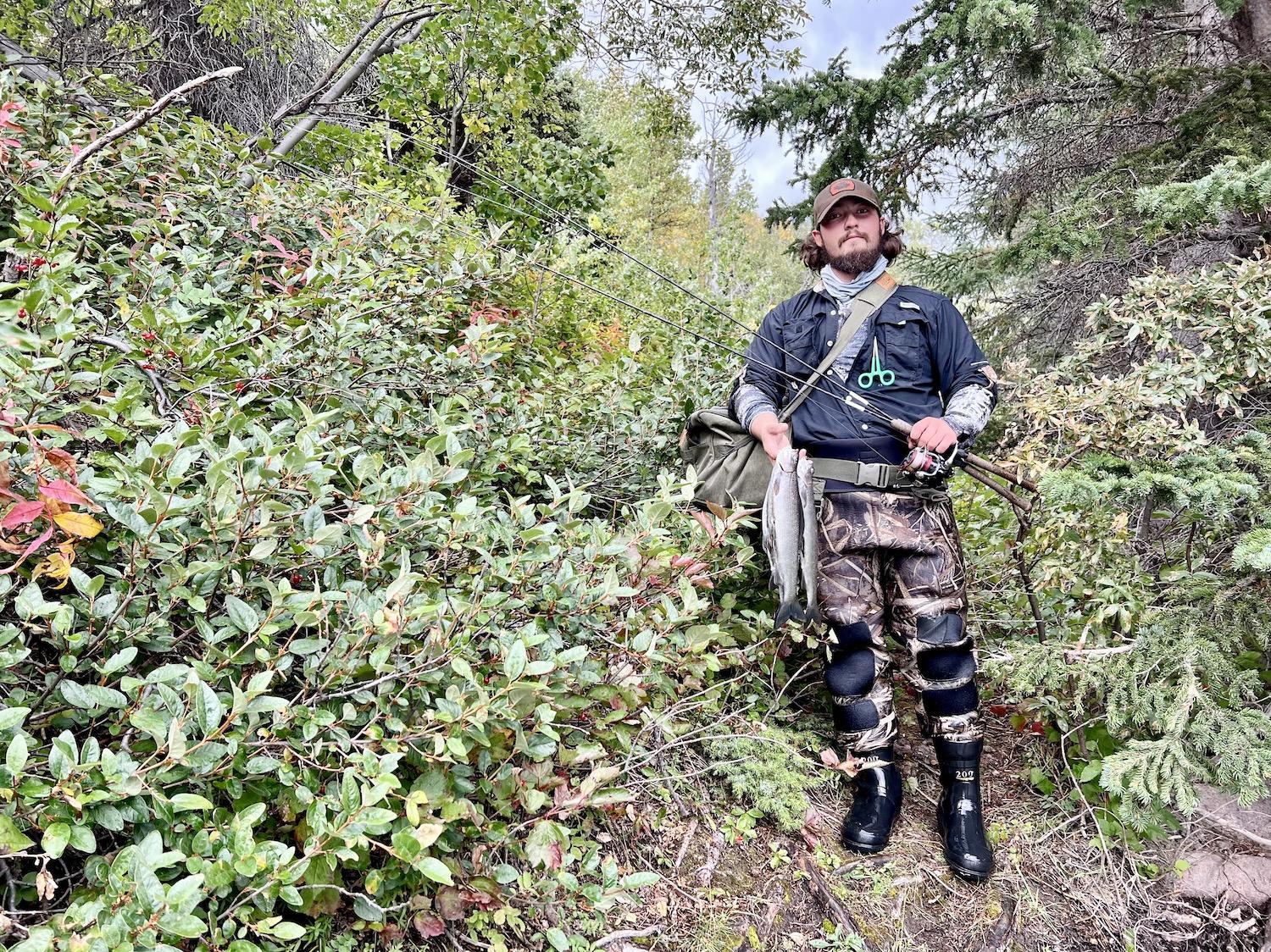
Dalton Trail Lodge fishing guide Matt Corrente with Arctic grayling in Kluane National Park and Reserve/Jennifer Bain
I’ve come to this lodge, founded in 1987 by Hardy and Trix Ruf from Switzerland, to fish in Kluane’s accessible wilderness. Kathleen Lake is a two-hour drive from Whitehorse, capital of this territory with just 43,000 people, and just minutes from the lodge. It’s full of lake trout — which I grew up fishing — and Arctic grayling, which I’ve never caught. Most lodge guests want to catch and release trophy fish, but I dream of catching my dinner like I did as a kid with my dad.
This is not the place to catch your limit. “Our thing is you only keep what you're going to eat the same night,” stresses Corrente. “So that's why normally you keep one lake trout and one grayling and you have it as an appetizer before your dinner.” This is his first season working as a fishing guide in the Yukon, but he's a seasoned angler and hunter with five years of experience leading salmon trips on Lake Ontario.
We hop in one of the lodge trucks and pull a 24-foot Hewescraft closed cabin, deep-water fishing boat to the lake, Kluane fishing permits from Parks Canada in hand because the usual Yukon fishing licenses aren't valid here.
While Corrente launches the boat and readies the gear, I scour bulletin board signage that details how anglers may keep two lake trout, four Arctic grayling and four round whitefish. Lake trout that are 26 to 39 inches long — and grayling that are 16 to 19 inches long — must be released. Rainbow trout and kokanee salmon must also be released.
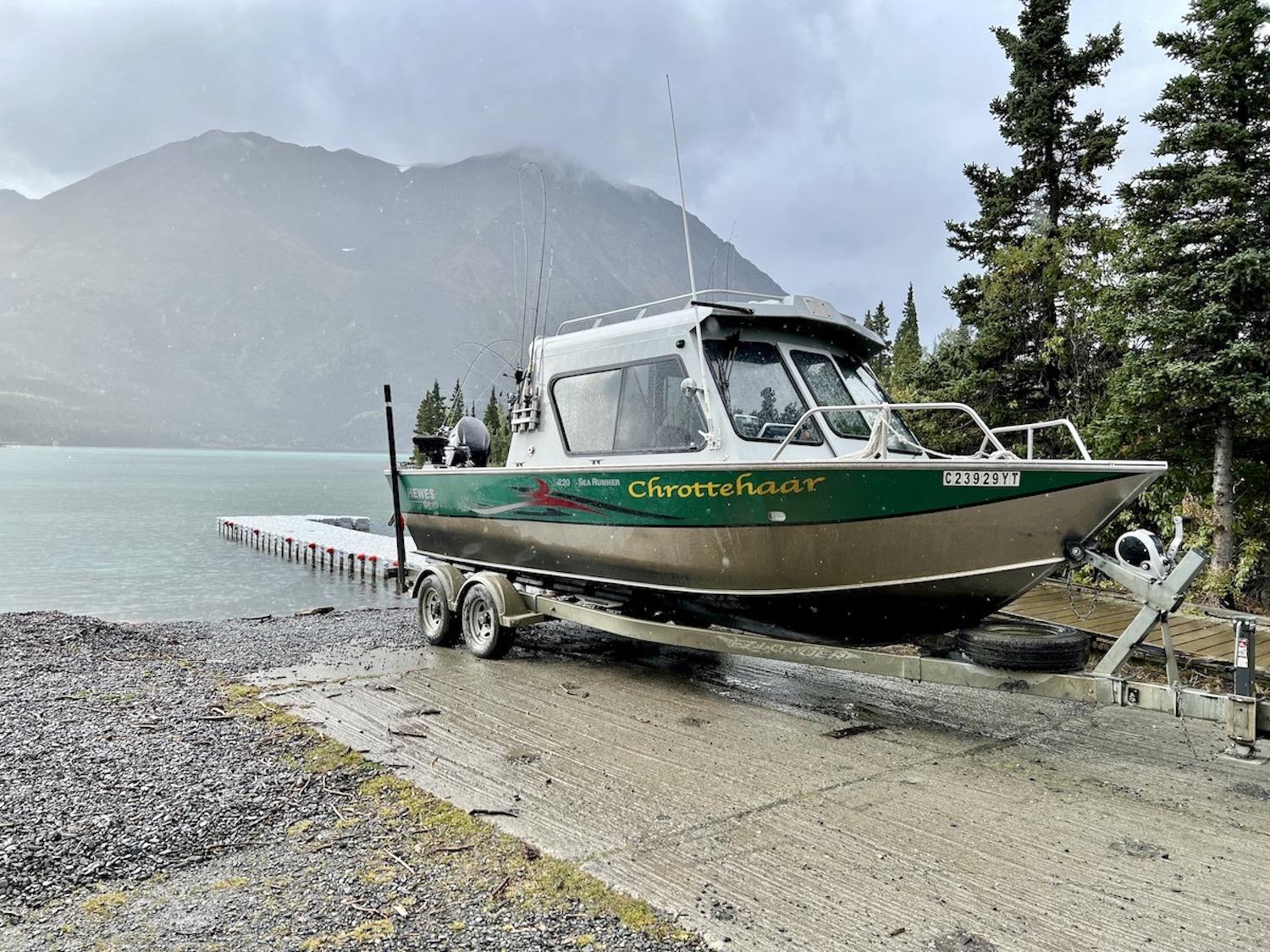
Launching the boat at Kluane's Kathleen Lake/Jennifer Bain
I’ve never seen a kokanee and so find it helpful to study photos that show how the slender, silver-bluish fish with a short dorsal fin and spot-free body turns red when spawning. I might mistake it for the also slender and silver grayling, but that species has scattered black dots and an oversized, sail-like dorsal fin.
The onus is, as always, on anglers to correctly identify their catch and release any kokanee. “If you don’t know, let it go,” is Parks Canada’s mantra and charges under National Parks of Canada Fishing Regulations come with a mandatory court appearance.
My fishing buddy and I take time to stroll Kokanee Trail, a short, wheelchair-accessible boardwalk that skirts the south shore of the lake behind one of four private cabins in the area that pre-date the establisment of the park. Interpretive signs on this trail and outside the nearby day-use shelter and picnic area tell the fascinating story of the kokanee — and its puzzling decline.
Most salmon begin life in a stream, migrate to the ocean to reach full maturity and return to their birth stream to spawn.

Kokanee salmon, shown in Kluane National Park and Reserve, turn red when they're ready to spawn/Parks Canada
Not Kluane’s kokanee. Parks Canada believes they evolved from sockeye salmon that migrated from the Gulf of Alaska up the Alsek River into the Kathleen Lake system and became land-locked when the Lowell Glacier surged and blocked their return to the ocean.
These kokanee — the name for all land-locked sockeyes — now complete their entire lifecycle in the glacier-fed, turquoise waters of the Kathleen Lake ecosystem.
When they are four years old, kokanee undergo dramatic changes to reproduce. Males turn bright red on the back and sides with “dirty white underparts” and develop a slightly humped back and elongated jaw, while females turn a darker shade of red.
They spawn upstream in late August and early September in Sockeye Creek, an outlet to Sockeye Lake, where females dig nests in the gravel with their tails before releasing up to 1,000 eggs for males to fertilize. Females then use their tails again to cover the eggs with gravel. Once all the eggs are laid, the adults die.
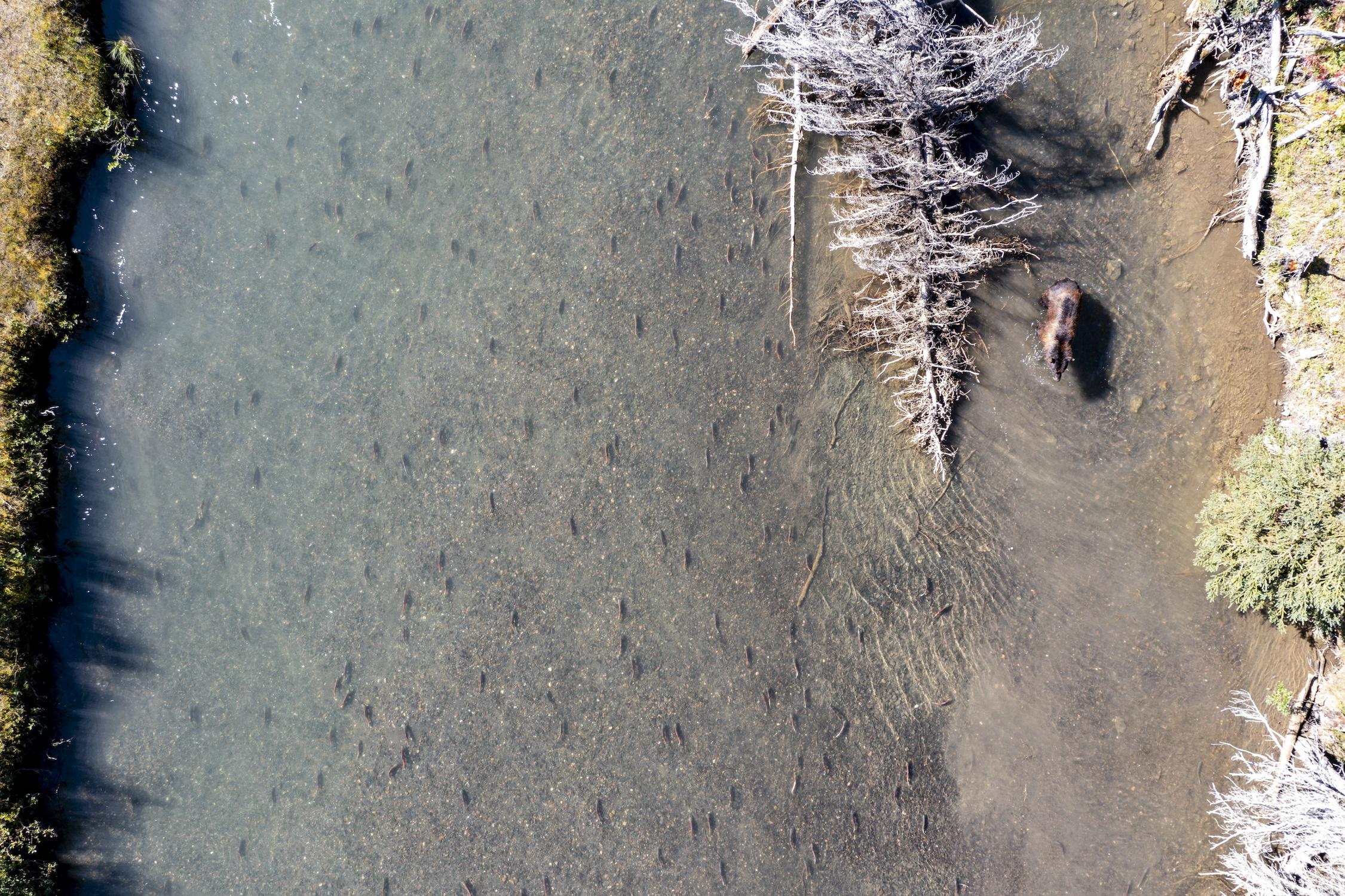
In August 2021, Parks Canada captured this drone shot of a grizzly fishing for kokanee salmon in Sockeye Creek/Parks Canada
Kokanee eggs hatch in January or February as “alevins,” which remain in the gravel but are nourished by egg sacs attached to their bodies. Alevins develop into “fry” in a few months, emerge from the gravel and ride the currents downstream. They spend three years in the lake before beginning the cycle again in their fourth year.
But here’s where what feels like a positive story of adaptation takes a troubling turn. Kokanee once spawned by the thousands here, but numbers began to plummet in 2002 and nobody knows why.
Parks Canada quickly closed the sport fishery in 2004 but has actually been counting spawning kokanee salmon since 1976. Historical counts averaged 3,660 and the highest count was 7,952 in 1995. That dropped to 730 in 2002 and 20 in 2009, before rebounding to 5,500 in 2015 and 2016. The most recent counts were 2,963 in 2020 and 2,731 in 2021.
“This confirms the need for precautionary management,” the park concludes in the December 2021 issue of its newsletter Fish Eye on Kluane’s Kokanee Salmon. “When the population is in a bust-phase of its cycle, it is at a higher risk of local extinction.”

Kathleen Lake with a morning mist and views of King's Throne Trail/Jennifer Bain
Answers to the kokanee mystery remain elusive. Is the problem competition with other fish? Did the kokanee lose an important food source? Did something change in the spawning stream? Or is this simply part of a natural cycle? Parks Canada works with the Champagne and Aishihik First Nations and water scientists to monitor the fish. They test water quality, net spawners and examine them for disease, sample the water for food sources and collect weather data. Right now they're studying the potential impacts of turbidity (sediment in the water making it cloudy) and water chemistry on spawning.
The Southern Tutchone name for this place is Mät’àtäna Män, meaning “something frozen inside lake.” The complete meaning is a mystery, but people who visit Kluane are often treated to the sight of members of the Champagne and Aishihik First Nations and Kluane First Nation exercising their traditional harvesting rights by hunting, trapping, fishing and gathering plants for food and medicine.
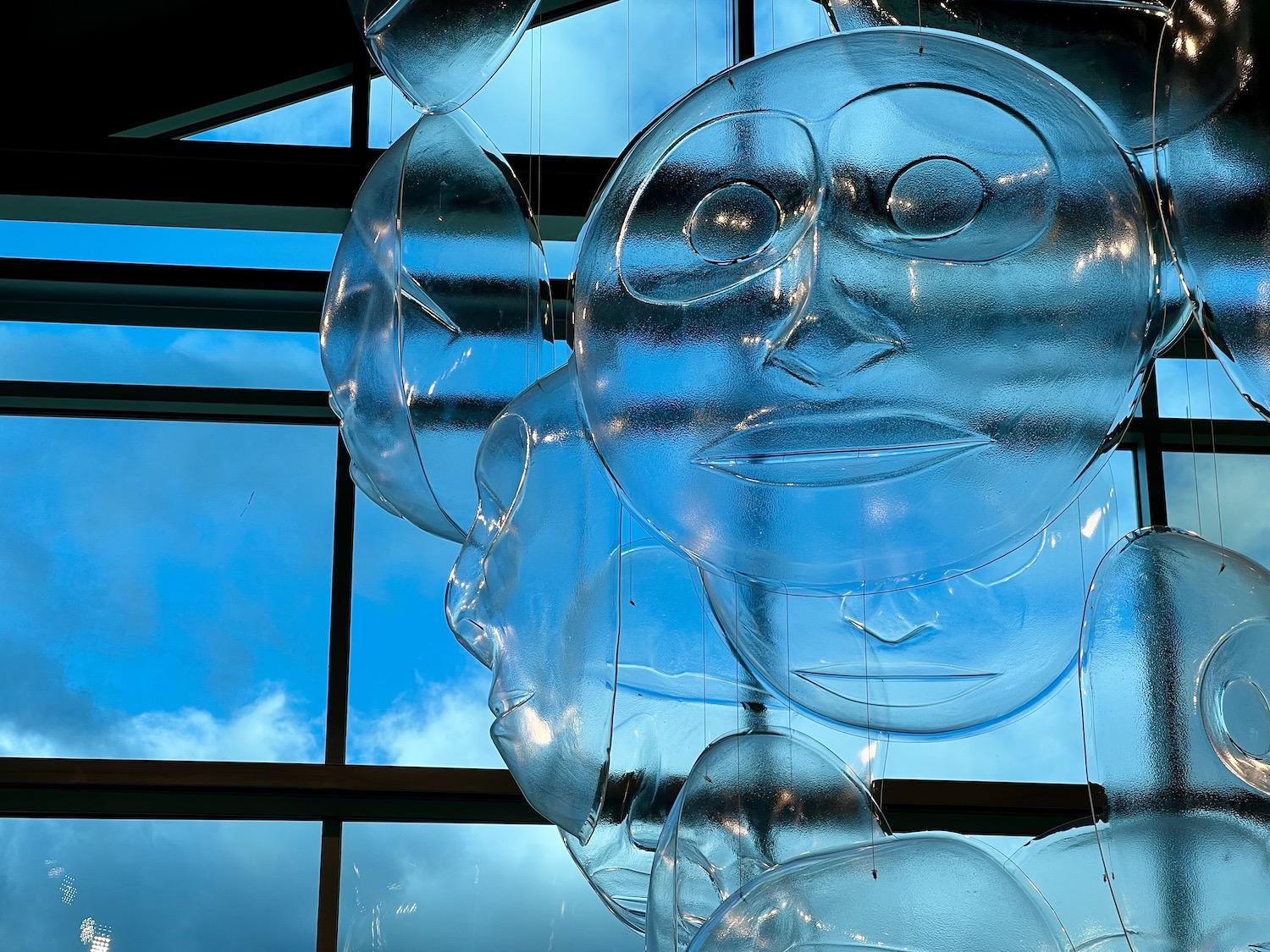
In the Haines Junction Visitor Information Centre, an installation by Tlingit artist Doug Smarch Jr. called Ice and Flowers was inspired by the first drops of water in spring, which reflect back on the faces that look at them/Jennifer Bain
Not today though. The lake is also too windy for kayakers and canoeists, so we troll around alone in the shadow of the Kluane Range mountains. Kluane shares UNESCO World Heritage Site status with Alaska’s Wrangell-St. Elias National Park and Preserve and Glacier Bay National Park and Preserve, and British Columbia’s Tatshenshini-Alsek Park. Together, these four neighbors from two countries make up the largest internationally protected area on earth at 24.3 million acres.
From the Kluane National Park Visitor Centre — which is in the Da Kų Cultural Centre with Travel Yukon's Haines Junction Visitor Information Centre — I learn that 80 per cent of Kluane is made up icefields and glaciers, and just three per cent is made of freshwater rivers, lakes and wetlands. Gravel bars and sediment left by creeks and rivers make up more than two-thirds of that three per cent.
“Life can’t survive without water,” reads an interpretive sign, “so what little freshwater there is in the park is critical.”
North America’s highest mountains, vast icefields and glaciers cover most of Kluane, but there are “narrow rivers of green.” This 20 per cent — homeland to the Southern Tutchone for millennia and rich in plants and wildlife — is where most visitors travel and includes freshwater spots, boreal forest, alpine areas and rock and talus.
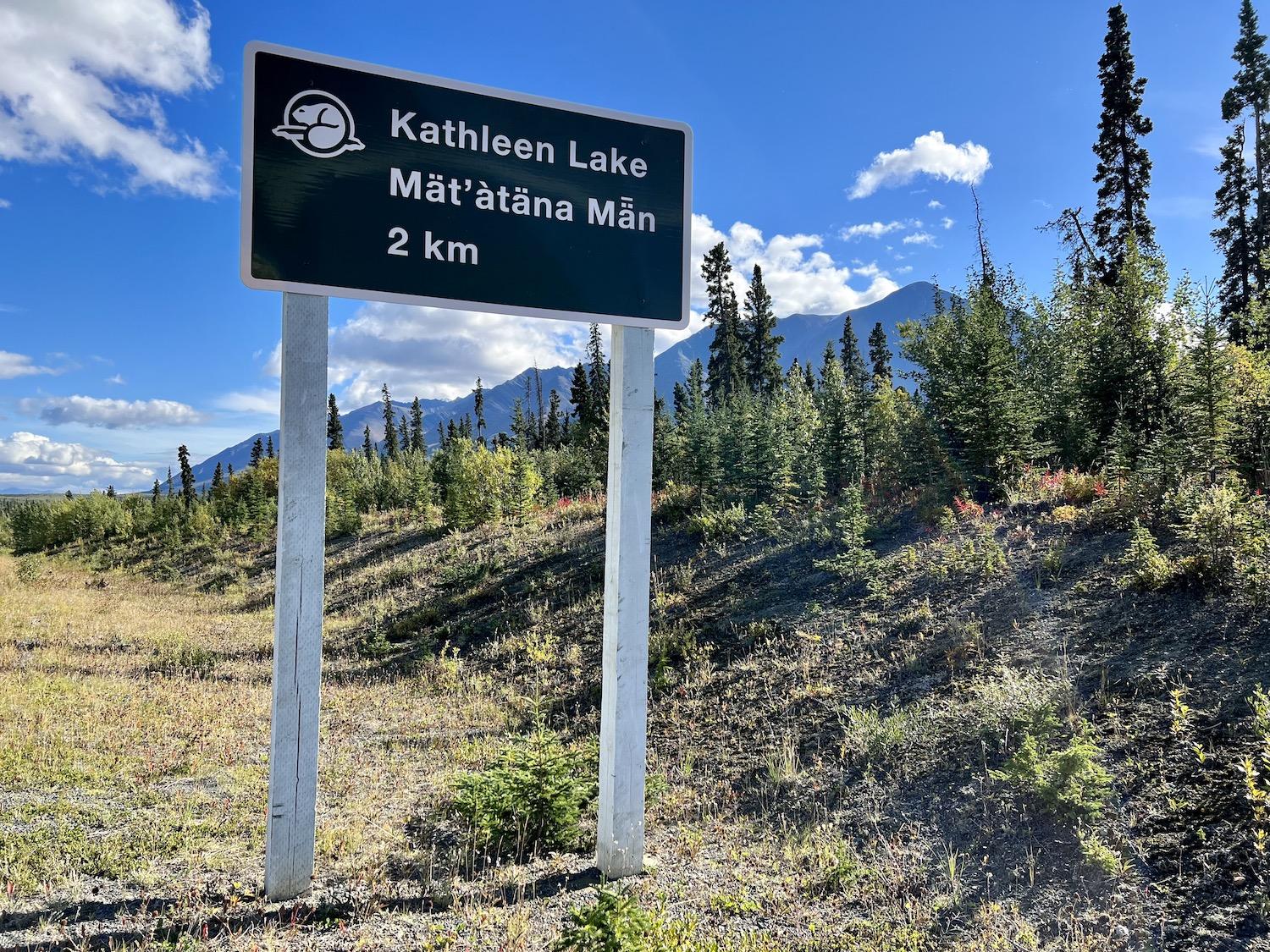
The sign for Mät’àtäna Män (Kathleen Lake) incorporates the Southern Tutchone language with English/Jennifer Bain
Anglers gravitate to Mush Lake, Bates Lake, St. Elias Lake and Kathleen Lake, which is known for very cold water and sudden, intense winds that can capsize boats. There’s a 38-site campground set back in the woods and from the boat launch we can see King’s Throne Trail, a steep trail up to an alpine cirque, a kind of natural amphitheater (aka “seat” of the throne) formed by glacial erosion.
Motorboats are welcome on this lake but can’t travel on to Louise Lake. Sockeye Lake and Sockeye Creek are closed to protect spawning areas.
Corrente whisks us across the lake so we can do downrigger trolling for lake trout in 130 feet of water. Hooks must be barbless and we can’t use fish as bait, like I did as a kid. It feels like cheating to stay warm and dry in the cabin and wait for the rods to subtly bounce instead of holding my rod and braving the elements in a small and basic boat. It also doesn’t take long to marvel over that stunning, but fleeting, rainbow and catch our supper.
“There’s usually better numbers here, but smaller fish,” Corrente admits. “This lake is super special. It’s one of the most beautiful ones and having the mountains come into the water is pretty cool.”
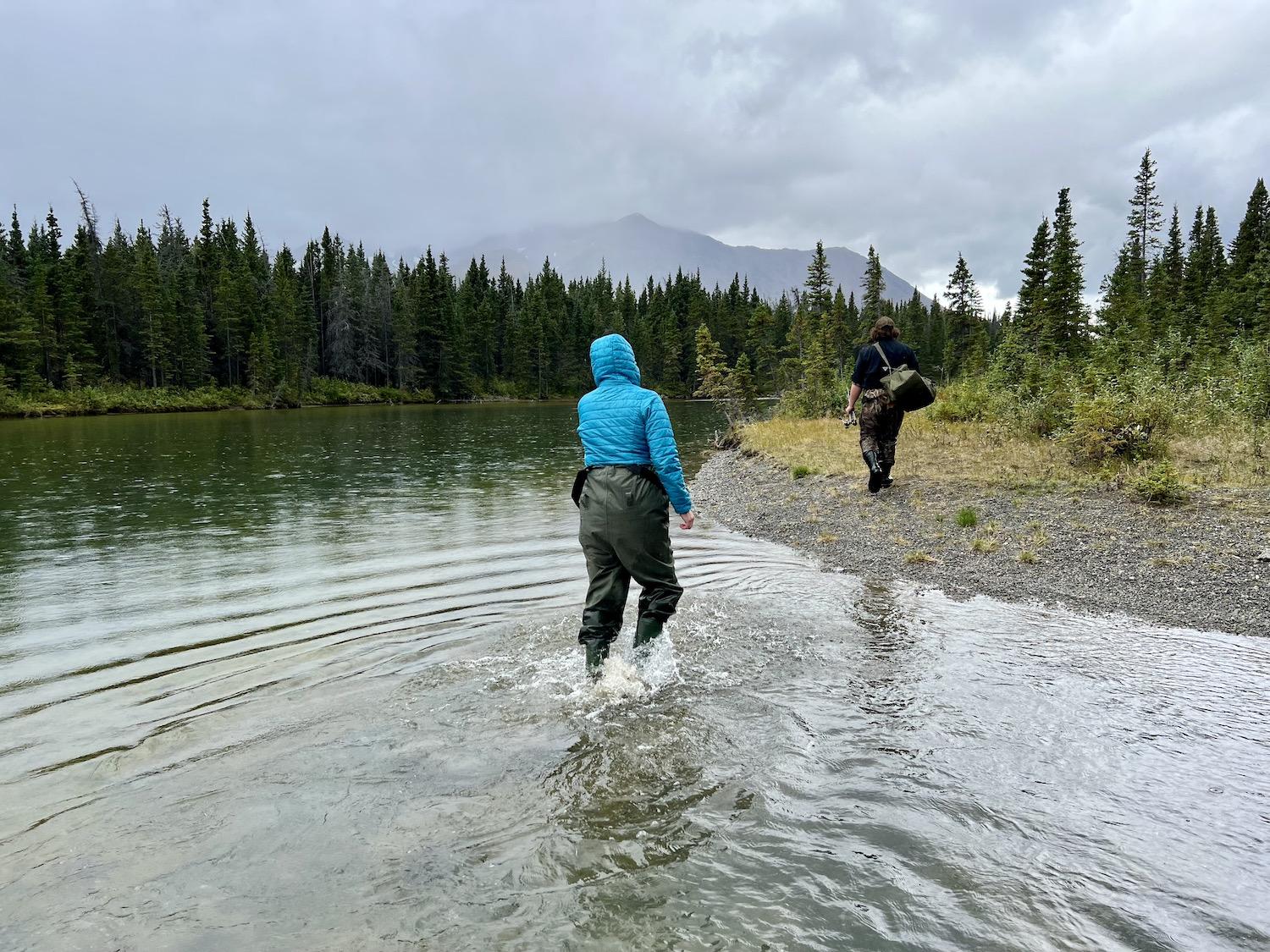
Leaving the boat and walking, in waders, to a spot to cast for Arctic grayling/Jennifer Bain
It seems like this lake is full of fish but there are plenty of spots where you won't catch anything if you don't know where to go. On a record day this summer, Corrente's cliients caught and released 50 lake trout. But we're not here for that kind of thrill so ask to leave the lake trout behind and move to new spot for grayling.
“I love grayling fishing because you can just reel them in, you don’t need a net and they’re very beautiful,” my fishing buddy confides.
“They are,” agrees Corrente, who hopes to become a marine engineer and work on freighters and ships around the world.

Casting for grayling in the shallow, turquoise waters of Kluane National Park and Reserve/Matt Corrente
We travel to what feels like the start of a river but is actually the inflow of Kathleen Lake and outflow of Louise Lake. Anchoring in the shallow water and donning waders. we trudge along the shore and through the bush to a favorite grayling spot at a bend in the river with little eddies of swirling water.
“I have bear spray so if we happen to see a bear, I will scare it away so you’ve got nothing to worry about,” Corrente assures us before handing over ultralight spinning rods rigged with little jigs and plastic minnows.
“We’re going to cast them out in a couple of inches of water and get a bunch of grayling,” he predicts. “Grayling like to sit and wait for bugs to come down and any bait fish — that's what they feed on. I think they’re too small and too fast for the grizzles to be able to get them.”
He’s right on all fronts. No grizzlies appear and we hook feisty grayling with almost every cast as Corrente stands by with forceps to quickly release them.

Walking back to the boat after catching grayling/Jennifer Bain
I wonder whether it feels different to fish in a national park.
“Not really,” Corrente muses. “I go around to so many different lakes, it’s just another lake for me. But most lakes we fish here, there’s no other people operating on them, which is nice because most of the time you’re going out and you have the lake to yourself.”
We do have this lake — and a second, more ordinary, rainbow — to ourselves when we make our way back to the boat launch. There aren't any parks staff to greet us and ask how we fished, what we fished and how successful we were. But last year, they spent 32 days conducting 125 angler surveys here and were happy to report that just 17 per cent of people they spoke to hadn’t heard of the kokanee decline, down from 30 per cent in 2015.

Arctic grayling (top) and lake trout (bottom) fillets cleaned by fishing guide Matt Corrente/Jennifer Bain
All of the kokanee signage and education efforts around Kluane are paying off.
“We don’t have answers yet, but it’s a cool story to connect people to the area,” says Rachelle Linde, a public outreach and education officer who helped lead a Cross-Canada Virtual Road Trip for nearly 1,800 North American students in May. The segment, now on YouTube, was called “The Case of the Missing Kokanee Salmon.”
Kluane is a land of many mysteries. Home to Canada’s highest mountain (Mount Logan, at 5,959 metres/19,551 feet is second only to Alaska's Denali in North America) and the world’s largest non-polar icefields, its 2,000 glaciers usually move very slowly, but some “can suddenly jump to life” and advance up to 1,000 times faster than usual. Only four per cent of all glaciers surge, Parks Canada says, and Kluane is one of just six major concentrations of surge-type glaciers on the planet. Again, nobody knows why.
In some traditional stories told by First Nation Elders like Marge Jackson, glaciers surge when people are disrespectful. The Southern Tutchone call the Lowell Glacier “Nàlùdäy” (Fish Stop) for the glacier surge in the 1700s that created this enormous lake and blocked Pacific salmon from coming up the Alsek River to spawn. The dam broke with a lethal vengeance around 1850, but the kokanee remain, still blocked from reaching the ocean but evolving into smaller versions of their sea-going cousins and embracing the freshwater lifestyle.

Dalton Trail Lodge bakes our lake trout and Arctic grayling as an appetizer/Jennifer Bain
Corrente has seen two kokanee since May, but today they are safely in their protected spawning waters.
My afternoon fishing trip under the rainbows of Mät’àtäna Män wraps up after the grayling bonanza so we can get back to the lodge by 5 o'clock and freshen up for dinner. I follow Corrente into the cleaning shack where he deftly fillets the fish, leaving the skin on the lake trout and removing it from the grayling.
Behind the scenes in the kitchen, the cooks take these ordinary fish that live alongside extraordinary kokanee salmon and bake them with wine, garlic, lemon and secret spices. I see them one last time once they become a bonus appetizer in a four-course dinner and easily outshine even bison meatballs and blueberry cream puffs.

Comments
What a great story! This was a pleasure to read, and I really enjoyed the photos.